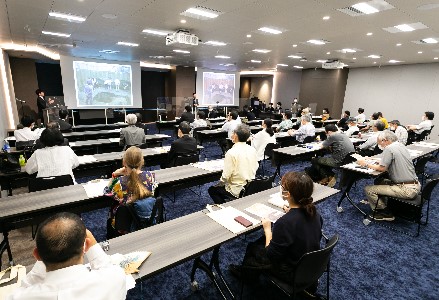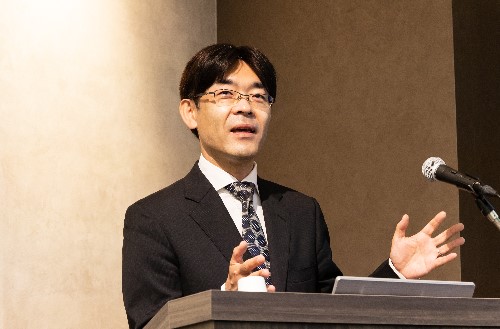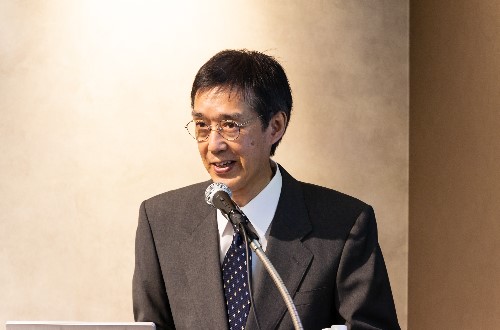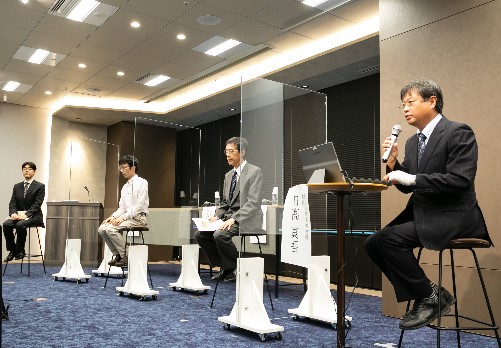No.068 - 39th NIHU Symposium “Reconstructing Urban Disasters and the Paths of Typhoons in the Edo Period: A Climatology, Archaeology, and History Collaboration”
39th NIHU Symposium
“Reconstructing Urban Disasters and the Paths of Typhoons in the Edo Period:
A Climatology, Archaeology, and History Collaboration”
The 39th NIHU Symposium was held at the Co・Mo・Re Yotsuya Tower conference room on October 9, 2021. A large audience viewed the symposium both at the conference venue and through live streaming. The symposium introduced some of the results of a research project on the theme of “Climate Models in the Edo Period” done in collaboration with researchers from different fields. The project, organized by Professor Watanabe Kōichi of the National Institute of Japanese Literature, has been ongoing since 2016.
The symposium was opened by President Hirakawa Minami of the National Institutes for the Humanities (NIHU). Introductory remarks about the aim of the symposium by Watanabe were followed by lectures by Ishigami Hiroyuki (archaeologist and professor at Kyoto University of the Arts), Hirano Junpei (climatologist and associate professor at Teikyo University), and Watanabe himself. Professor Hidaka Shingo of the National Museum of Ethnology then presided as moderator at a panel discussion with the three speakers. The speakers fielded many questions and comments from the audience, both at the venue and online, rounding off the symposium successfully with much valuable discussion. The following are summaries of the three lectures and the gist of the panel discussion.

Symposium at Co・Mo・Re Yotsuya Tower conference room
1. Professor Ishigami Hiroyuki “What Archaeology Revealed about the Remaking of the Landscape and Urban Space in Edo”
Following Tokugawa Ieyasu’s entry into Edo in the late sixteenth century, the topography of the city underwent various land alteration projects, and the development on low swampy terrain in the eastern part of the city generated risk factors that made the city prone to natural disasters. The rapid development along the eastern bank of the Sumida river in the wake of the Great Fire of Meireki in 1657 led to the expansion of vulnerable areas where soil liquefaction would easily occur as an inevitable consequence of the reclamation of swampland. Based on archaeological excavations, attempts are being made to reconstruct the topographical and geological conditions of Edo that had a major bearing on natural disasters. For example, an excavation at Nishi Shinbashi conducted at the time of the construction of Tokyo Loop Road No. 2 confirmed an artificial sedimentary layer built by filling and ground leveling upon the natural sedimentary layers of the Ancient and Medieval periods. On the coast of Edo Bay, meanwhile, reflecting a strong consciousness of the water level of the Bay and the Arakawa river, stone walls and banks were built in the effort to protect the area against tidal surge and other disasters, providing a glimpse of the disaster countermeasures practiced in Edo

Ishigami Hiroyuki, professor at Kyoto University of the Arts
2. Associate Professor Hirano Junpei “Reconstruction of the Paths of Typhoons Based on Climate-related Historical Materials”
Only 150 years have passed since meteorological observation officially started in Japan, and historical meteorology has been conducted based on weather data collected over that period. In addition, diaries, calendars, tree rings, and so on from the Edo period and earlier began being utilized as important research resources. Diaries generally included weather-related notes such as about weather conditions and wind direction, and utilizing such data makes it possible to reconstruct various natural phenomena. Drawing on the data of Nihon kishō shiryō (Historical Documents of Weathers in Japan; 1939, edited by Central Meteorological Observatory and Marine Meteorological Observatory), The Complete Journal of Townsend Harris: First American Consul General and Minister to Japan (1930), and other diaries, the Hirano report examines the paths of the “Siebold Typhoon” of 1828 and the “Ansei Edo Typhoon” that hit Edo on the 25th and 26th days of the 8th month of Ansei 3 (1856). Relationships between typhoon path and wind direction are such that the eastern side (the “dangerous half”) of the path is where the wind blows counter-clockwise and is strongest, whereas on the western side the wind blows clockwise and its velocity is slower. The report assumes the paths of typhoons by confirming the changes in wind direction from the diaries and other sources. In this way, it has become possible to develop information on weather, wind direction, and air flow written in diaries both two- and three-dimensionally, presenting valuable material and methodology for historical meteorology.
Hirano Junpei, associate professor at Teikyo University
3. Professor Watanabe Kōichi “Damage from the 1856 Ansei East Japan Typhoon and Edo’s Response”
The storm winds and tidal flooding brought by the Ansei Edo Typhoon of 1856 wrought massive damage in the city of Edo. Documents submitted by local domains to the shogunate concerning the damage suffered reveals that not only Edo but all eight provinces of the Kanto region were affected, making it a large area disaster that could be called the “Ansei East Japan Typhoon.” In Edo, the areas along the shore of Edo Bay and the banks of the Sumida river suffered the severest damage from tidal flooding and heavy winds, and the dreadful impact of the disaster is depicted in the Ansei fūbunshū (The reportage of Ansei Edo Typhoon) and other sources. In response to the typhoon disaster, the shogunate has enforced a crackdown on the soaring prices of building materials and craftsman wages to promote reconstruction. Old records also show that wealthy merchants joined in quick recovery efforts mobilizing their financial resources and that ordinary people, too, coordinated among themselves to promote their own recovery. Natural disaster-related historical sources tell not only the extent of the destruction but post-disaster reconstruction efforts from the viewpoints of the government and of daily life as well.

Watanabe Kōichi, professor at the National Institute of Japanese Literature
4. Panel Discussion
The audience posed many diverse questions for the three speakers who had reported, respectively, on the reclamation of low swampland that led to the Edo disasters, on the analytical findings about the paths of past typhoons, and on the state of a typhoon disaster and the efforts of both the shogunate and the private sector to deal with the aftermath of the disaster. The questions concerned the results of archaeological excavations in specific areas and analytical study of excavated debris, exchanges with overseas researchers and organizations in the field of climatology, the significance of study of the paths of typhoons, the reasons for the difference in the numbers of disaster victims between typhoons and earthquakes, and other issues and moderator Hidaka directed the questions at the speakers for responses, and lively interchange followed for much valuable discussion.

Professor Hidaka Shingo of the National Museum of Ethnology
presided as moderator at a panel discussion with the three speakers.
Text: Nagamura Makoto, Executive director of National Institutes for the Humanities, Director of NIHU Center for Information and Public Relations
*The symposium has been made publicly available on the NIHU YouTube channel.
